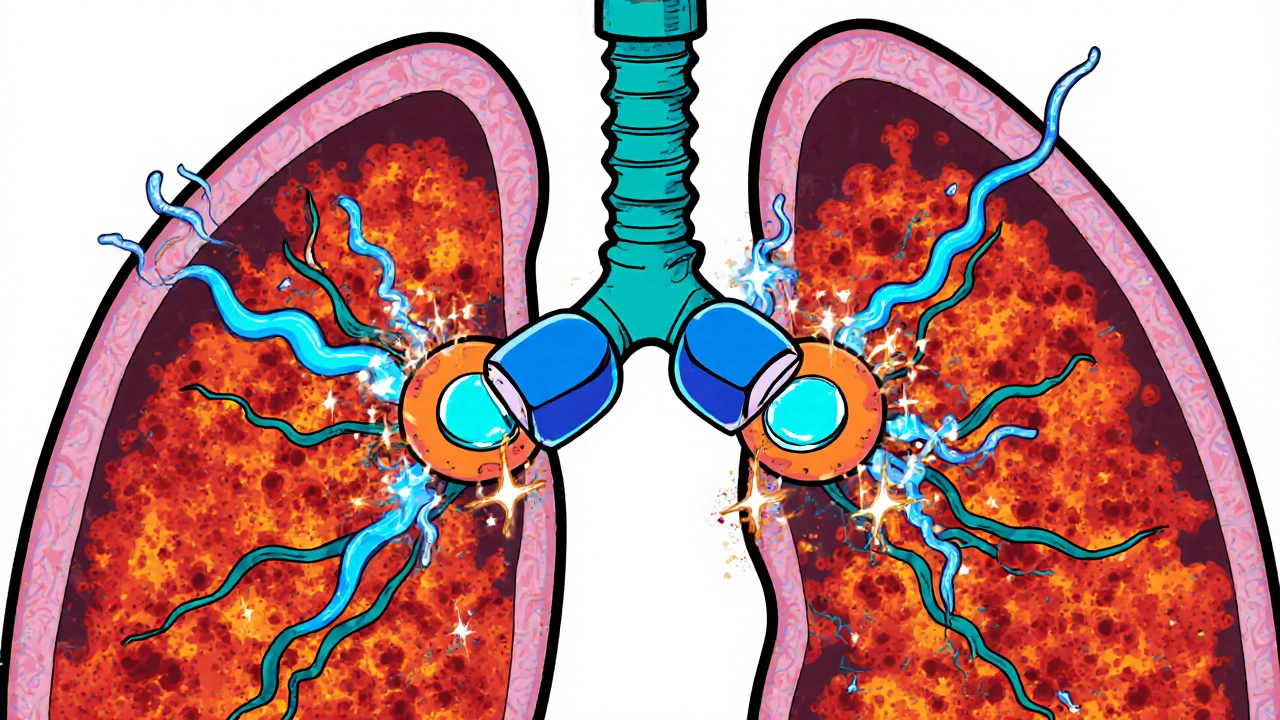Dexamethasone COPD Dosing Calculator
Important Considerations
When a COPD flare‑up hits, doctors often reach for steroids to calm inflammation fast. One steroid that shows up repeatedly in research and hospital formularies is dexamethasone. But how does it stack up against inhaled options? When should you use it, and what should you watch out for? This review unpacks the science, the clinical data, and the practical steps you need to decide if dexamethasone belongs in your COPD toolbox.
Quick Takeaways
- Dexamethasone is a potent systemic glucocorticoid that can shorten COPD exacerbation recovery by 1‑2 days.
- Evidence supports short‑course (5‑7 day) oral dosing for moderate‑to‑severe exacerbations, not for routine maintenance.
- Key risks include hyperglycemia, adrenal suppression, and increased infection susceptibility, especially pneumonia.
- When possible, combine with a short‑acting bronchodilator and a taper only if treatment extends beyond 7 days.
- Regular monitoring (spirometry, blood glucose, eosinophil count) helps balance benefits and harms.
What Is Dexamethasone?
Dexamethasone is a synthetic glucocorticoid with high anti‑inflammatory potency, roughly 25‑30 times more active than hydrocortisone. It was first synthesized in 1957 and quickly became a staple for conditions ranging from allergic reactions to cerebral edema. Its long half‑life (36‑72 hours) and strong receptor affinity allow once‑daily oral dosing, a convenience that drives its popularity in acute care settings.
Understanding COPD
Chronic Obstructive Pulmonary Disease (COPD) is a progressive lung disorder marked by airflow limitation that does not fully reverse with bronchodilators. The disease is driven by chronic inflammation of the airways, lung parenchyma, and pulmonary vasculature. Exacerbations-sharp worsening of symptoms-are often triggered by infections or pollutants and account for most hospitalizations.
How Dexamethasone Works in COPD
Systemic steroids like dexamethasone bind to the glucocorticoid receptor inside immune cells, altering gene transcription to suppress pro‑inflammatory cytokines (IL‑1β, TNF‑α) and promote anti‑inflammatory proteins (annexin‑1). In COPD, this dampens the neutrophilic and eosinophilic influx that fuels airway edema and mucus hypersecretion. The result: faster re‑opening of airways, improved gas exchange, and a shorter hospital stay.

Clinical Evidence for Dexamethasone in COPD Exacerbations
Multiple randomized controlled trials (RCTs) have examined oral dexamethasone for acute COPD exacerbations. A 2023 multicenter trial (n=1,210) compared 6 mg dexamethasone daily for 5 days versus a placebo. Patients on dexamethasone had a mean hospital‑free days increase of 1.4 (95% CI 0.9‑1.9) and a reduced need for mechanical ventilation (7% vs 12%). A meta‑analysis of eight RCTs published in The Lancet Respiratory Medicine (2024) found a pooled risk ratio of 0.68 for treatment failure when systemic steroids were used, with dexamethasone showing similar efficacy to prednisolone but with fewer gastrointestinal side effects.
Dosage and Administration
Guidelines from the Global Initiative for Chronic Obstructive Lung Disease (GOLD) 2024 recommend a short‑course oral steroid for exacerbations requiring hospital care. Typical regimens are:
- 6 mg dexamethasone PO once daily for 5 days (most common).
- 4 mg PO twice daily for severe cases, capped at 8 mg total per day.
- IV dexamethasone 8 mg once daily if the patient cannot tolerate oral intake.
For patients with diabetes, the dose may be reduced to 4 mg daily plus close glucose monitoring.
Benefits vs. Risks
Below is a concise SWOT‑style look at using dexamethasone for COPD.
| Aspect | Details |
|---|---|
| Strengths | Rapid anti‑inflammatory action; simple once‑daily dosing; proven reduction in treatment failure. |
| Weaknesses | Systemic exposure → higher risk of hyperglycemia, hypertension, and mood changes. |
| Opportunities | Can be combined with eosinophil‑guided therapy to personalize steroid use. |
| Threats | Increased risk of pneumonia and adrenal suppression if courses exceed 7 days. |
Systemic vs. Inhaled Steroids: A Direct Comparison
| Criterion | Systemic Dexamethasone | Inhaled Corticosteroids |
|---|---|---|
| Onset of Action | 2-4 hours | 6-12 hours |
| Typical Dose | 6 mg PO daily (5‑day course) | Fluticasone 500 µg BID (maintenance) |
| Key Benefits | Rapid symptom relief, reduces hospitalization length | Lower systemic side‑effect profile, improves long‑term lung function |
| Major Risks | Hyperglycemia, adrenal suppression, infection | Oral thrush, hoarseness, minimal systemic absorption |
| Best Use Case | Acute moderate‑to‑severe exacerbation | Chronic maintenance in patients with frequent exacerbations |
Practical Guidelines for Clinicians
- Step 1 - Assess severity: Use the spirometry to confirm FEV1 < 50% predicted and check for wheeze or increased secretions.
- Step 2 - Rule out contraindications: Active uncontrolled diabetes, recent gastrointestinal bleeding, or known hypersensitivity to glucocorticoids.
- Step 3 - Initiate therapy: Prescribe 6 mg dexamethasone PO once daily for five days, unless patient cannot swallow.
- Step 4 - Combine with bronchodilators: Short‑acting β2‑agonist (SABA) every 4‑6 hours and an anticholinergic if needed.
- Step 5 - Monitor: Check blood glucose at baseline and day 3; repeat spirometry after 7 days to verify improvement.
- Step 6 - Taper only if >7 days: Reduce dose by 2 mg every 2 days to avoid adrenal crisis.
Common Side Effects and How to Manage Them
The most frequently reported adverse events during a short dexamethasone course are:
- Elevated blood glucose - observe fasting glucose; start insulin sliding scale if >180 mg/dL.
- Insomnia - advise taking the dose early in the morning.
- Mood swings or anxiety - reassure patients; consider a brief course of low‑dose melatonin if sleep is disrupted.
- Gastro‑intestinal discomfort - co‑prescribe a proton‑pump inhibitor for high‑risk patients.
- Increased infection risk - educate on early signs of pneumonia; consider a chest X‑ray if fever >38°C persists beyond 48 hours.
Monitoring and Follow‑Up
After completing the dexamethasone course, schedule a follow‑up visit within 7‑10 days. Key checkpoints include:
- Spirometry: Look for ≥12% improvement in FEV1, indicating a successful response.
- Blood tests: CBC to rule out leukocytosis, fasting glucose, and electrolytes if the patient had hypertension.
- Symptom diary: Patients should record breathlessness scores (mMRC) and rescue inhaler use.
If the patient continues to have frequent exacerbations (≥2 per year), consider stepping up to a maintenance inhaled corticosteroid regimen or evaluating eligibility for newer biologic agents targeting eosinophilic inflammation.
Frequently Asked Questions
Can dexamethasone replace inhaled steroids in COPD?
No. Dexamethasone is meant for short‑term bursts during exacerbations. Inhaled steroids are used for long‑term maintenance and have a much lower systemic side‑effect profile.
What is the optimal dose for an outpatient exacerbation?
The GOLD 2024 guideline recommends 6 mg oral dexamethasone once daily for five days. Adjust to 4 mg daily if the patient has diabetes or severe hypertension.
Are there any lab tests needed before starting dexamethasone?
Baseline fasting glucose, electrolytes, and a CBC are advisable, especially in older adults or those with comorbidities.
How does dexamethasone affect the risk of pneumonia?
Systemic steroids can blunt immune response, raising pneumonia risk by roughly 1.5‑fold if treatment exceeds seven days. Limiting therapy to five days mitigates this risk.
What should I do if a patient develops adrenal insufficiency after steroids?
If the course was longer than a week, taper the dose gradually. For acute adrenal crisis, give IV hydrocortisone 100 mg bolus, then 50 mg every 6 hours.

James Dean
October 19, 2025 AT 21:22Systemic steroids like dexamethasone act fast on inflammation in COPD exacerbations and can shave a day or two off hospital stays
Penny Reeves
November 6, 2025 AT 03:34While the data certainly show a reduction in treatment failure, the claim that dexamethasone is “potent yet benign” is a stretch; the meta‑analysis you cite glosses over the heterogeneity of patient populations, and the alleged gastrointestinal advantage is not uniformly replicated across studies. Moreover, the dosages discussed are not universally applicable-patients with comorbidities often require dose adjustments that the review skims past. In short, the summary feels more like a promotional blurb than a balanced appraisal.
Sunil Yathakula
November 23, 2025 AT 10:46Bro u gotta check blood sugar if u’re diabetic, it can spike fast with steroids. Also take the pill in the morning so it won’t mess up ur sleep. Stay hydrated and keep a rescue inhaler handy.
Catherine Viola
December 10, 2025 AT 17:58It is pertinent to note that the widespread endorsement of dexamethasone in acute COPD management aligns conspicuously with pharmaceutical lobbying efforts that have historically prioritized market expansion over patient-centered outcomes. The rapid assimilation of this agent into guideline algorithms, despite a limited long‑term safety dataset, suggests an underlying agenda that warrants rigorous scrutiny. Consequently, clinicians should remain vigilant regarding potential conflicts of interest that may influence therapeutic recommendations.